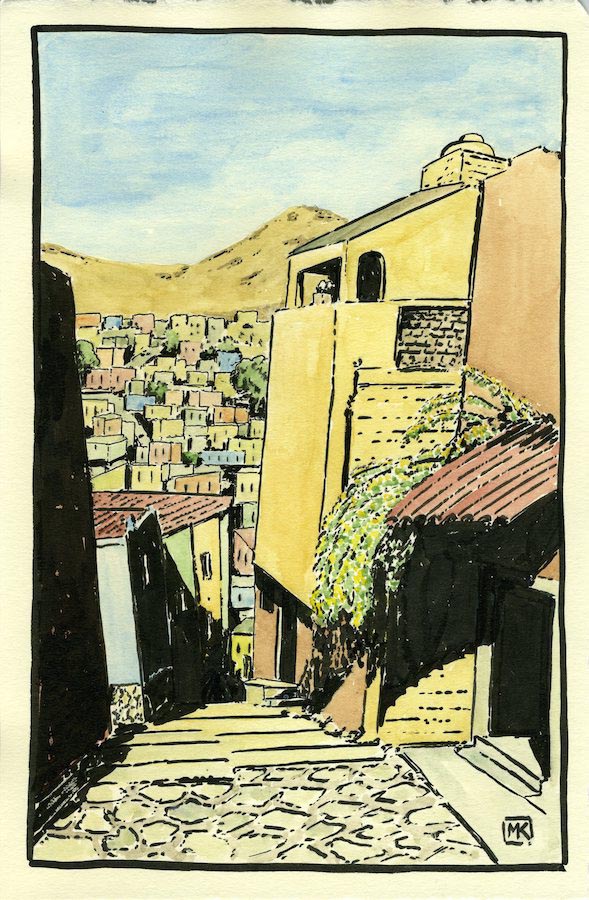
Contact me Go to home page Return to main travel page
Back to Mexico, 2024
Michael Kluckner
| Our best place for a winter break, Mexico
is a wonderful jumble of friendly people and interesting towns and
cities. (We don't go to the beach resorts.) There are previous
trips on this site to Oaxaca/Cuernavaca/Taxco
in 2019, Mérida and the Yucatan in
2018, Mexico City/Guanajuato/San Miguel de
Allende in 2015, and Guadalajara in
2003. This was our first trip back since Covid. Everywhere we went was busy and lively, although we did feel that Cuernavaca had fallen a little on hard times without so many day-tripper gringo tourists from Mexico City (CDMX) – it's only about a 1-1/2 hour bus ride from the Tasquena station at the end of the Metro line in south Mexico City. 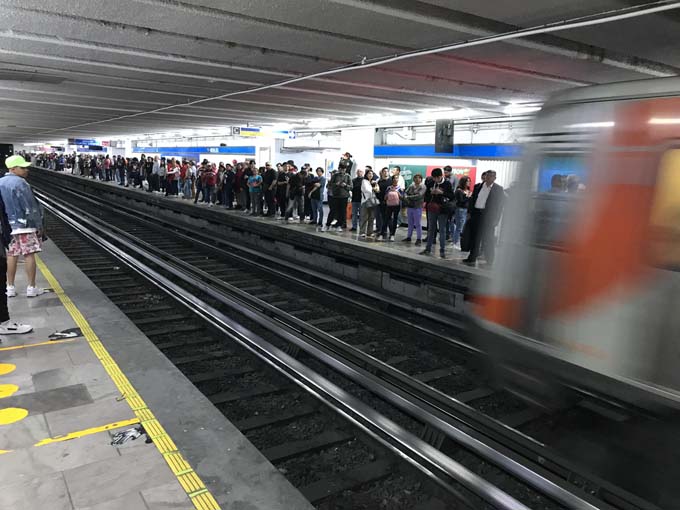 Typical Metro station – lots of people and crowded trains! Mexico City is incredibly vibrant, probably my favourite big city in world. Yes, it has its problems with a population that might be as high as 20 million, water shortages and air pollution, but the Centro Historico is full of beautiful architecture and makes European cities seem dull. One time in the Bar La Opera, where we went every night, we got talking with a young Mexican woman who summed it up perfectly. "It's a mess," she said, "but I love it." We always stay at the Hotel Gillow at the corner of 5 de Mayo and Isabella Catholica in the Centro Historico. This is its atrium. 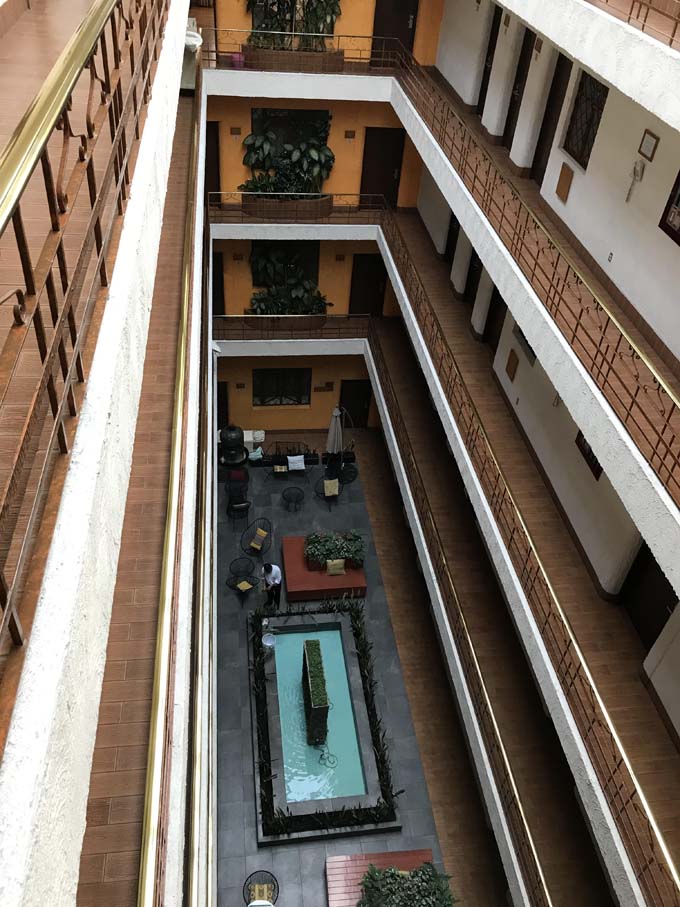 Drawings not paintings: the little pencil Moleskine sketchbook and a pencil, sometimes attacked later with coloured pencils, are my travel kit. I can work on drawings for a few minutes here and there once I've started them "on site" and gotten them to the point that the memory kicks in and helps me finish them. No question, in my opinion they're not as good as the watercolours I used to do while travelling, but it's a much more spontaneous, in-the-moment way of documenting a trip. Below: Bar La Opera. The best drawing of it is the one I did first on the 2015 trip. |

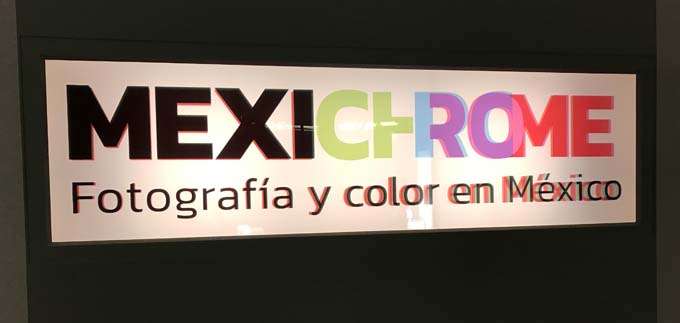
| Below: the 6th floor rooms at the Hotel Gillow have small terraces, pretty noisy but great for a little sunshine and views down onto the street. There are homeless on the Centro Historico streets, but fewer than in North American downtowns like Vancouver's, and no open drug use. Men still struggle to pull heavily laden handcarts through the busy streets, shoeshiners do a steady trade, and the organ grinders – all dressed the same in tan-coloured uniforms – still turn their cranks and pump out squeelly music, sometimes holding their hats out for spare change. |
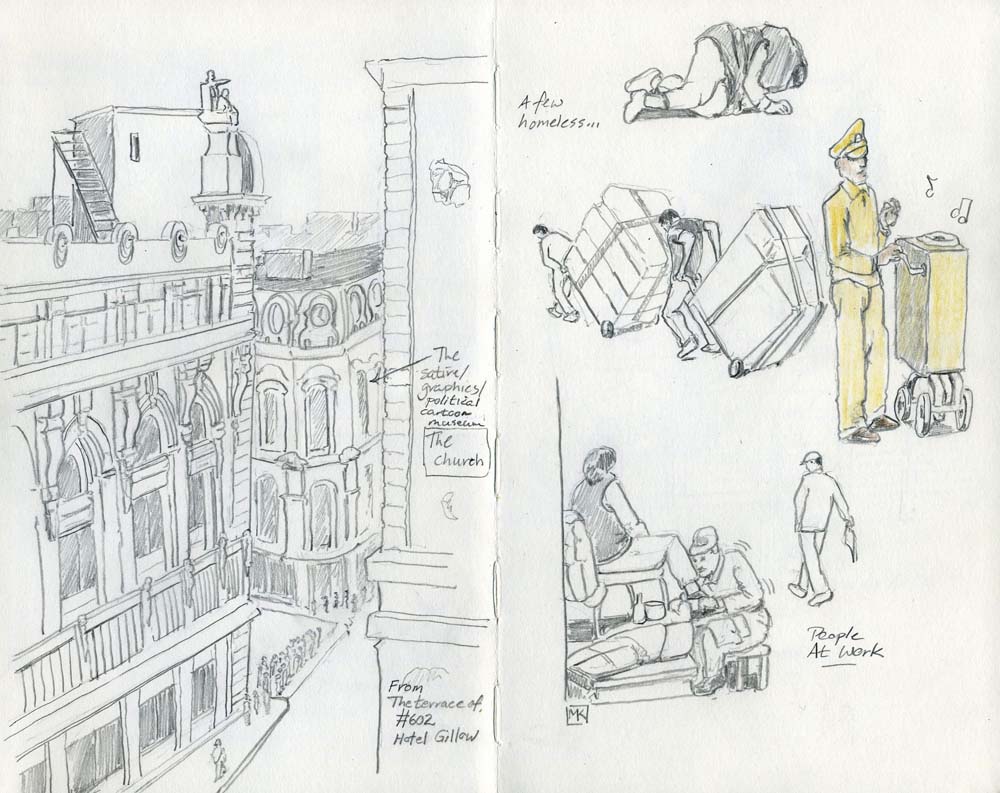
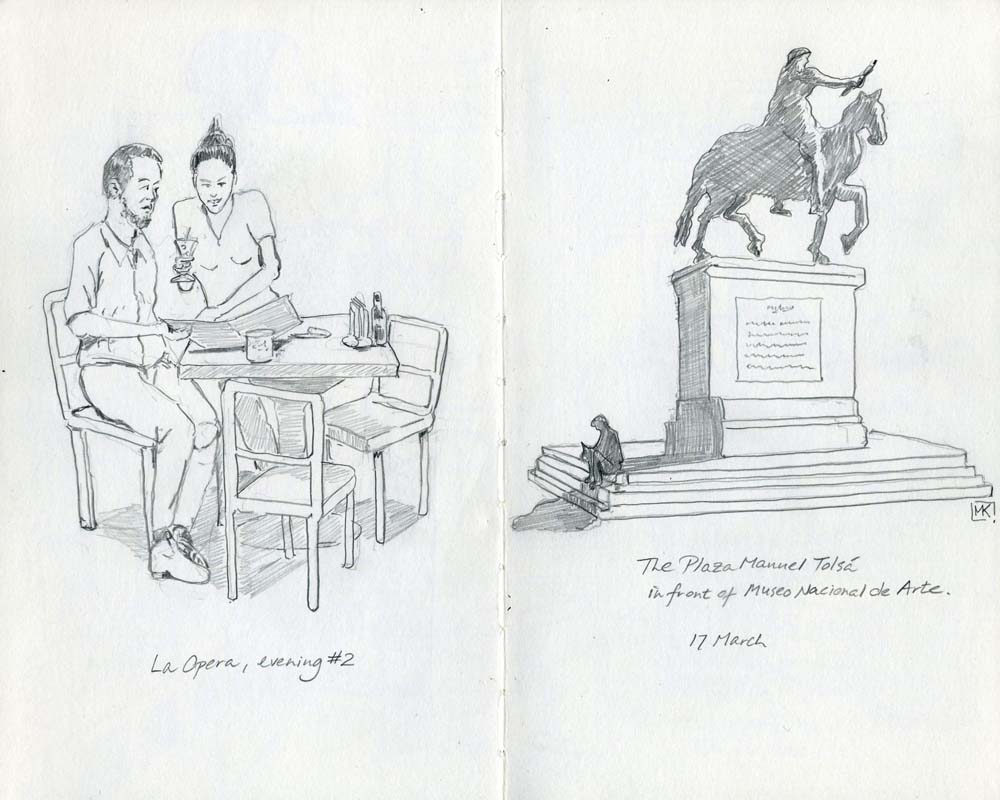
Below: Mexico City's best Modern skyscraper, the Torre Latino Americana, and our best café for breakfast.
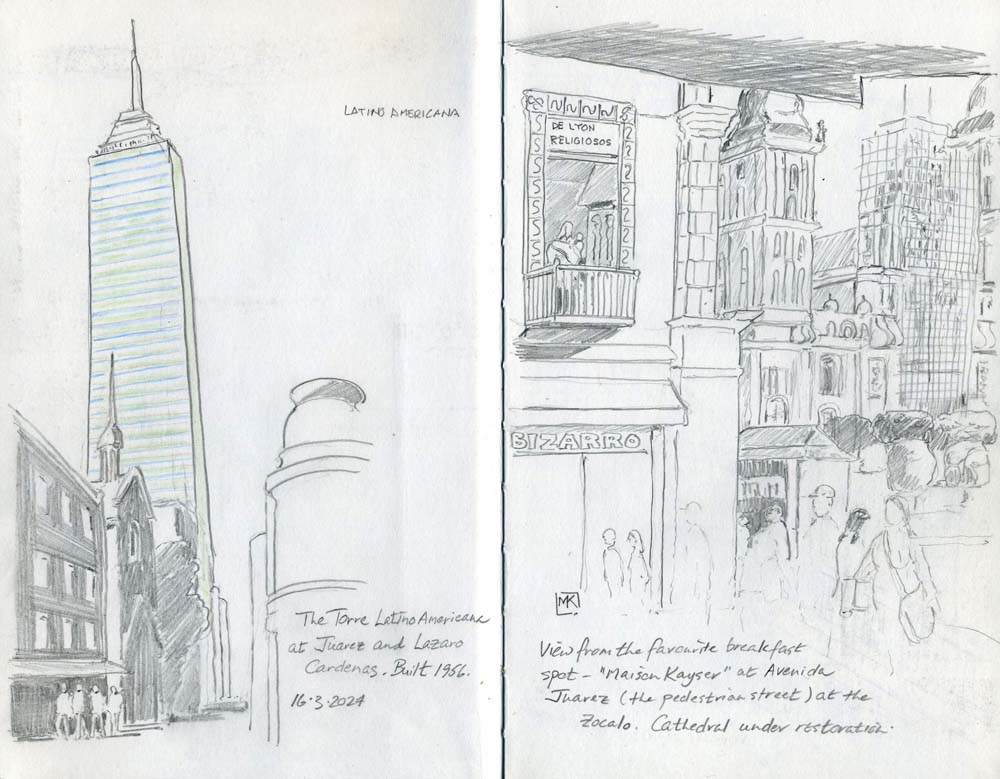
| Below: every evening in La Opera a trio plays guitars, sings
Mexican songs, and moves from table to table asking for requests
and gathering tips. The little taqueria, kitty corner from the Hotel Gillow, is open to the street and has the usual Mexican meals including the "al pastor" chicken or pork barbequing while it slowly rotates in front of a flame. In the drawing, the 'sanitarios higenicos' across the street is a typical public toilet costing about 7 pesos (about 65 Canadian cents/50 US cents). You get used to plugging coins into the machine and pushing quickly through the revolving bars. |

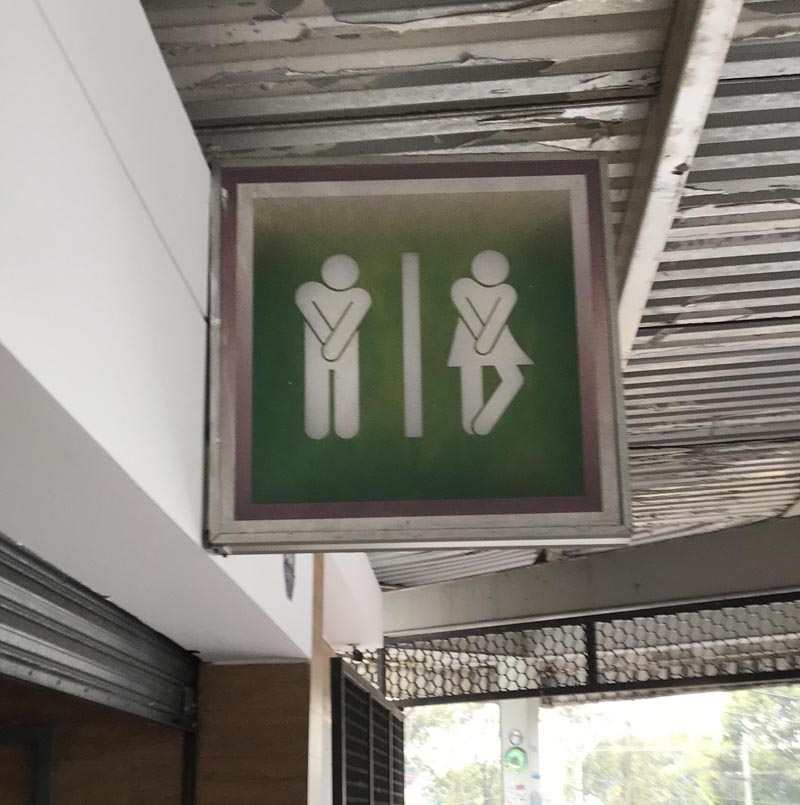
| Above: best-ever sanitarios sign, at the Tasquena metro stop in
south Mexico City. Below: a not very inspiring daytrip by bus from Terminal del Norte to the restored temples at Teotihuacan. Compared with Uxmal and Chichen Itza in the Yucatan, it was rather dull. People selling souvenirs and annoying noise-makers... |
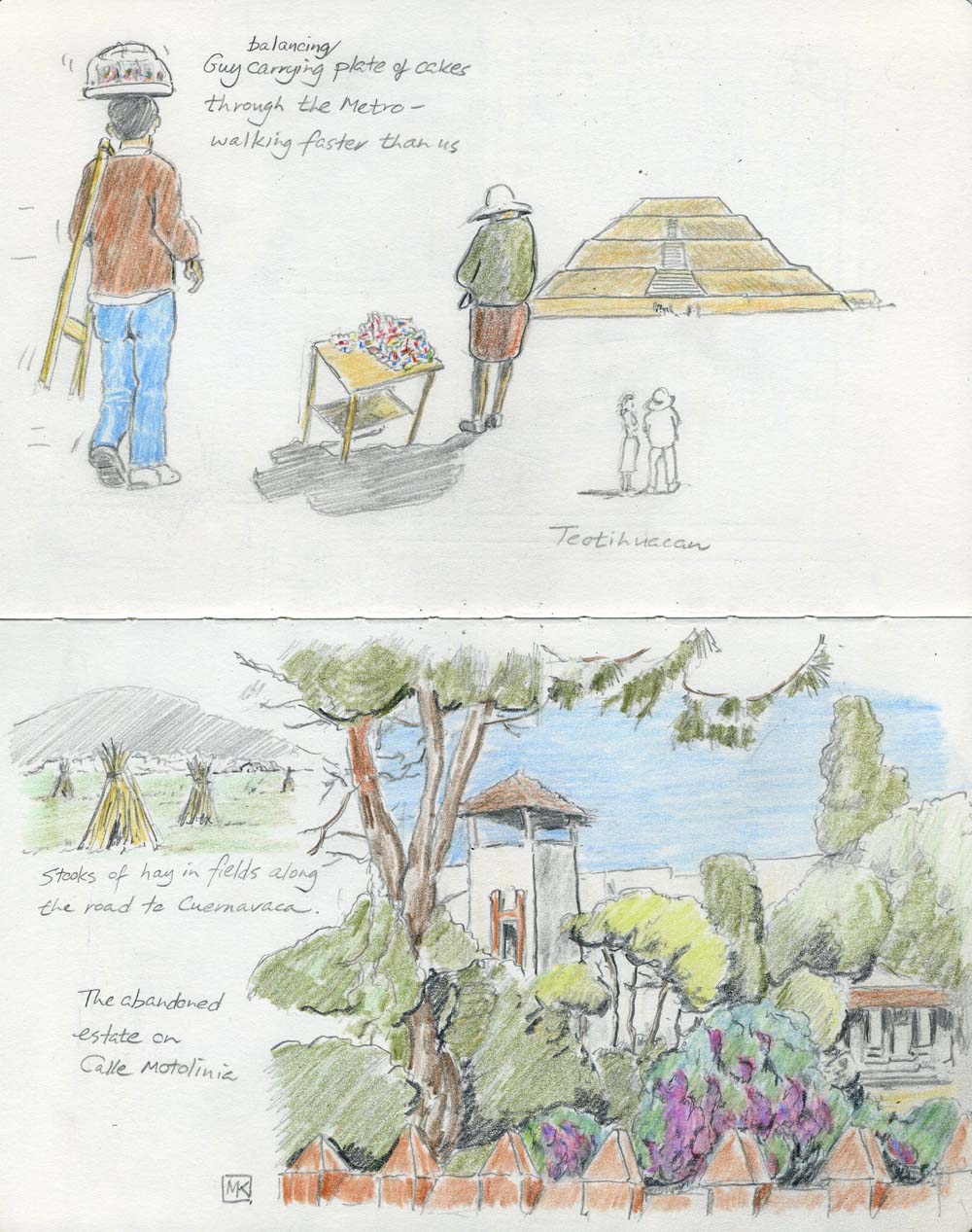
| Above and below: Cuernavaca is the place of eternal spring, back
in the day a place that attracted the wealthy. But it has had its
problems, including the gang and drug spillover from the
neighbouring state of Guerrero. A few of the big properties appear
to be abandoned, faded and dusty except for the bougainvillea that
thrives in the climate. One estate that is restored is the Museo
Robert Brady, home to an eccentric collection of art and (what can
only be described as) stuff that was worth revisiting. It was very easy for us to get to Cuernavaca: the Allende metro station is about two blocks from the Hotel Gillow; it's about 40 minutes to the end of the "blue" line at Tasquena; the Pullman Morelos line at the bus station there has a comfortable coach leaving there about every hour, and it arrives in Cuernavaca about two blocks from our favourite hotel: the Antigua Posada on Calle Galeana, a ten-minute walk from the Zocalo and many of the city's shops and cafés. |
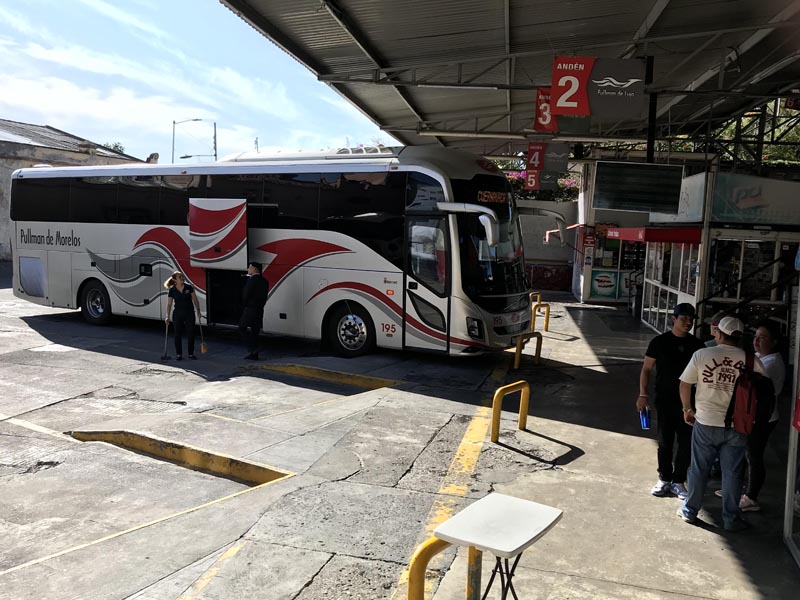
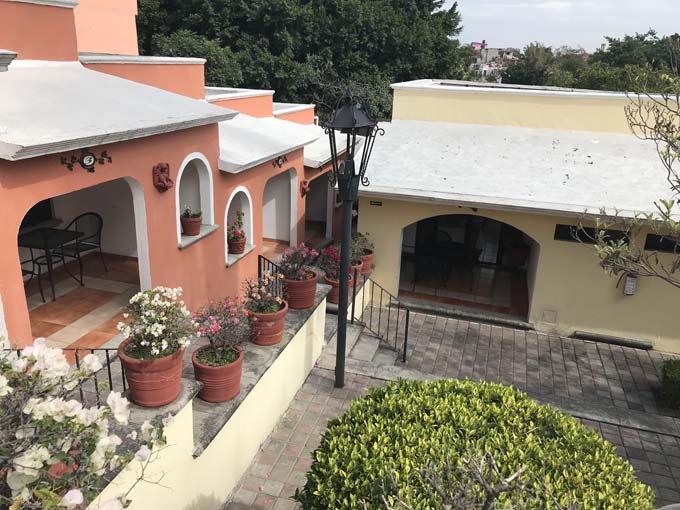
| Above: the Pullman de Morelos bus depot and the Hotel Antigua
Posada nearby. Below: Cuernavaca colours. The pink pencil crayon I have is a little too blue for the actual paint colour on many houses. |
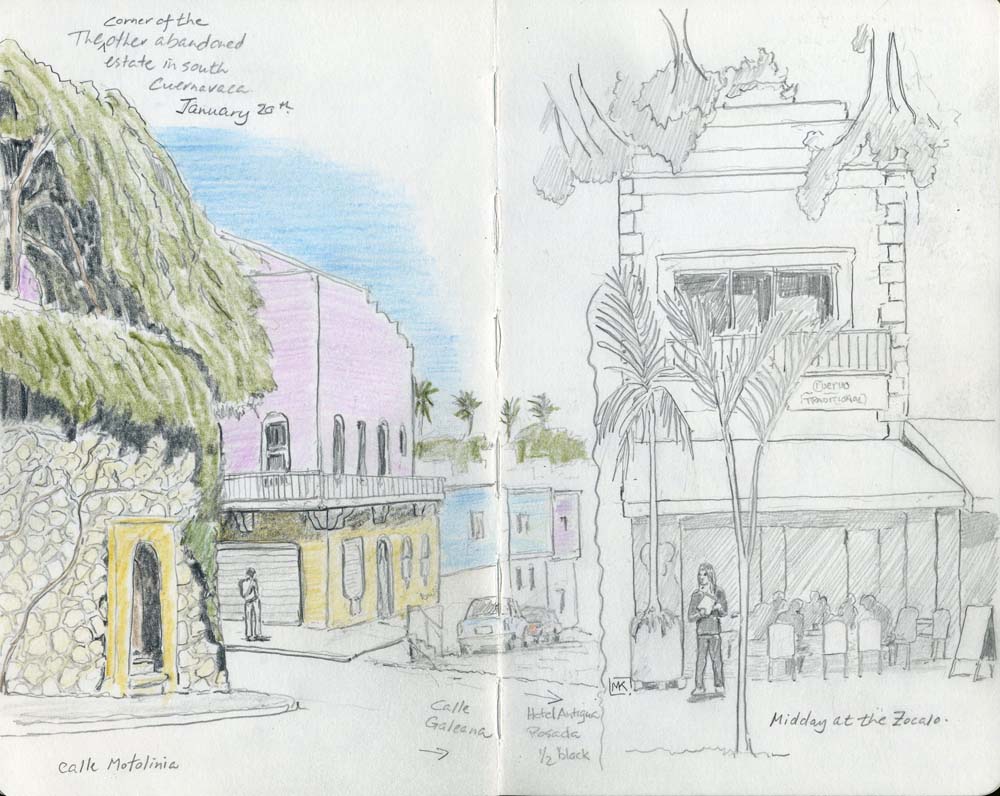
| Below: we visited the Jardin Etnobotánico y Museo de la Medicina
Tradicional in the southeast part of Cuernavaca and had it pretty
much to ourselves. Very tranquil and a bit overgrown, but lots of
signs on plants that we attempted to decipher from the Spanish to
identify and understand the traditional uses of native plants.
Bougainvillea and graffiti on a house near the jardin show what is
evidently a poor part of town. |
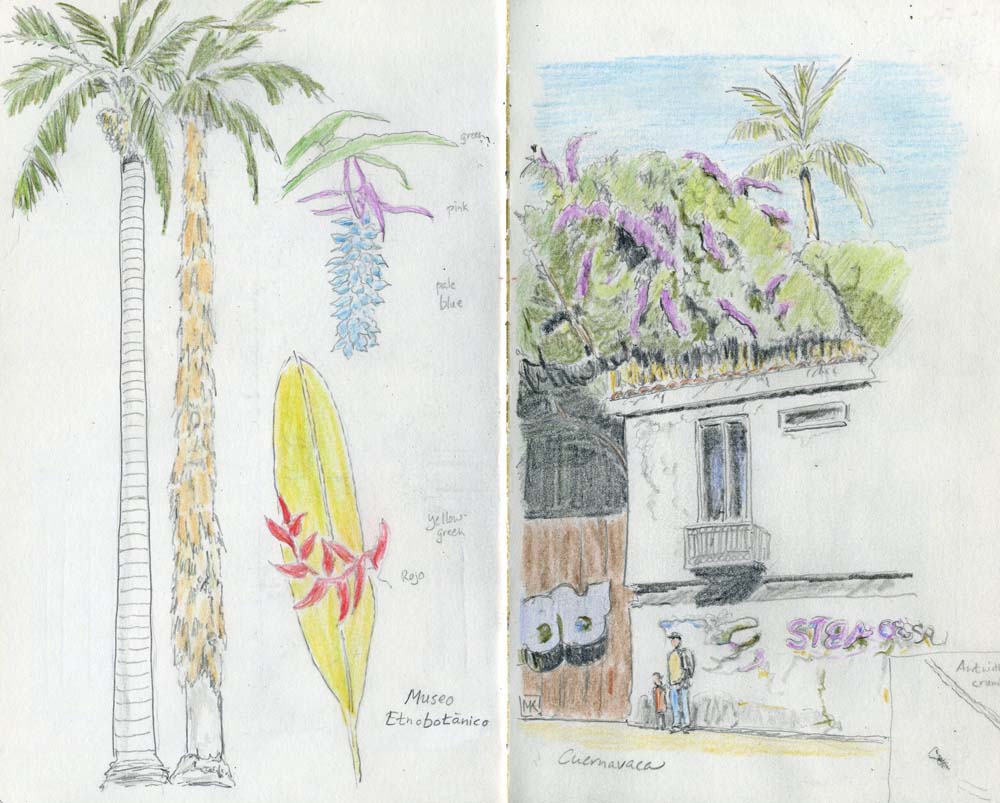
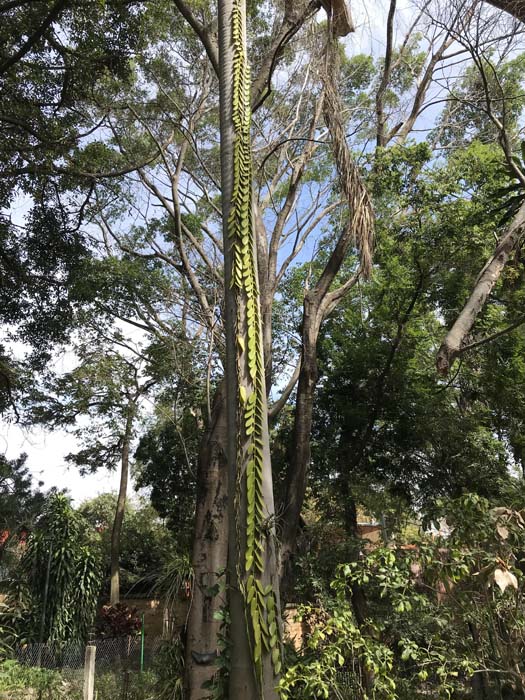
| Below bottom right: back to Mexico City, then continuing through
it on the Metro to Terminal del Norte and a bus to Guanajuato....
A long travel day. |
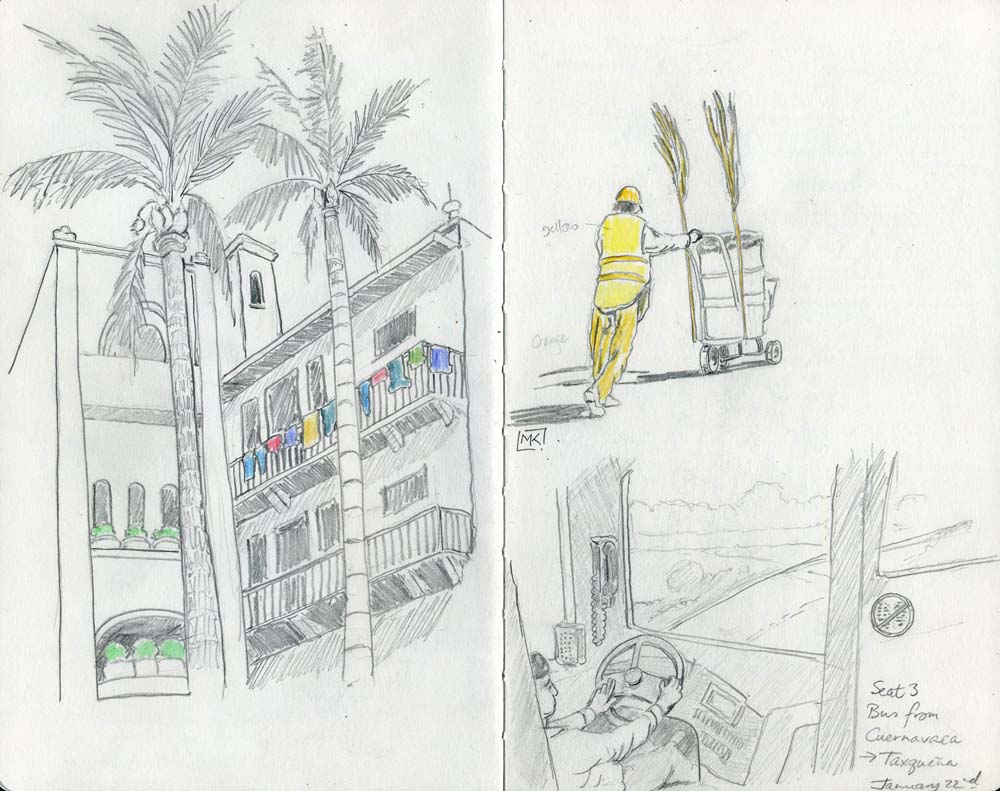
| Below: return to a favourite city, Guanajuato. Lots of
drawings there in 2015. On the right
page, the busker leaning against a wall in the big market used
what unfortunately has become a common tool: a battery-powered
boombox that plays karaoke background for his songs; he had
dropped his blue surgical mask under his chin while he sang into
the microphone. There are always water delivery people negotiating
the narrow cobblestone streets. |

| ...and a return to Truco 7 (the address as well as the
restaurant name) for a good dinner and the pleasure of its
collection of art and antiques. |


An ink and watercolour drawing done later, at home...

Rambling around, looking for inspiration to return to a few big oils....

like this one from 2015,
inspired by Guanajuato and Tangier.
And below, a favourite café, Los Gatos, with a friendly cat sitting on our table.
A cat face in the foam of the caffe con leche!

| Below: back to San Miguel de Allende for a few days. Buskers and
balloon sellers, lots of gringos and English spoken in the cafés.
It really is expat heaven, a kind of Mexico on training wheels for
Americans and Canadians. The guitarist-singer with flowers on his
guitar and hat quickly moved around the corner when he spotted
what I was doing. The balloon- and hat-sellers likewise noticed me
and fairly quickly turned their backs. Oh, to be invisible. |
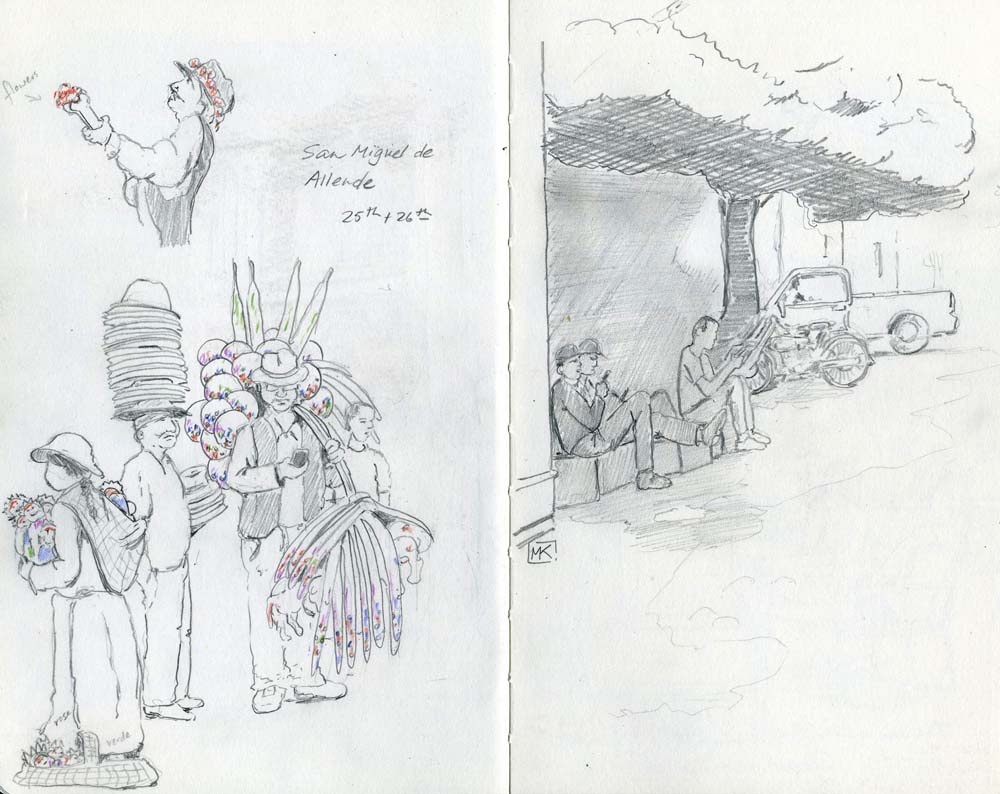
| I was curious about the aging gringos (who looked like us) on
the streets in San Miguel, mostly happily retired expats, some no
doubt permanent residents, and noticed a few solitary women
walking the streets. Had they become widows while living there?
Our friend David, who's lived in San Miguel for more than 15
years, told a local joke: A woman sitting by herself in a bar starts a conversation with a stranger. "I haven't seen you here before – are you new in town?" "Yes, I just got here." "Where were you before?" "I was in prison." "What for?" "I murdered my wife." "Oh good, then you're single!" |

| And, a few more photos with the cellphone... How could you not
love a city that has a bench like this? In Mexico City... |

And a green wall in a restaurant on Calle Isabella Catholica in the Centro Historico.
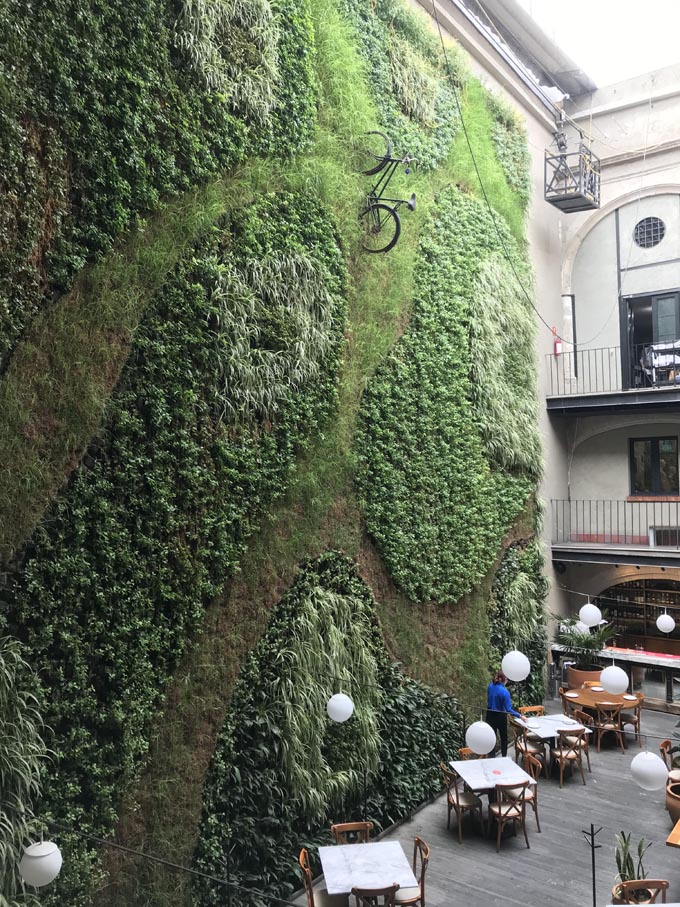
Contact me Go to home page Return to main travel page
Artwork & text © Michael Kluckner, 2024